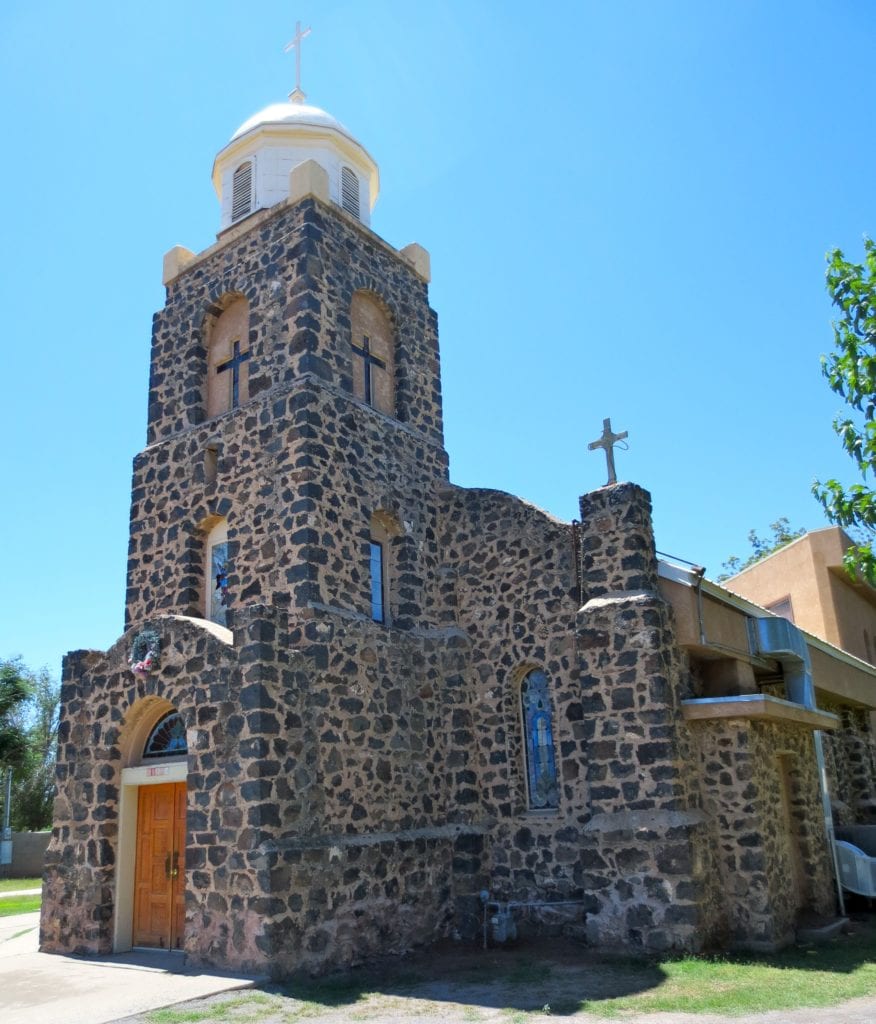Written by Rob McCorkle
The Don Juan de Onate Trail invites today’s travelers to follow in the hoof prints of the Spanish conquistador and his band of 400 colonizers in 1598 as they journeyed from New Spain (Mexico) north to find the fabled Cities of Gold in what is now northern New Mexico. Onate and his men, traveling El Camino Real (The Royal Road) that stretched from Mexico City to northern New Mexico, reached Paso del Norte (El Paso) on April 30, where he claimed the land in the name of the King of Spain, and continued days later along the Rio Grande to eventually establish the first Spanish capital at Okkay Owingeh Pueblo. The drive along the trail (Highway 28) is one of the Las Cruces area’s most scenic routes, crossing and flanking the Rio Grande from El Paso to historic Old Mesilla.
 Mesilla Plaza
Mesilla Plaza
The Mesilla Plaza, a National Historic Landmark, represents an excellent spot to understand the area’s bicultural roots and begin an afternoon trek along the Don Juan de Onate Trail. The 1848 Treaty of Hidalgo ended the Mexican-American War and established the village as part of Mexico. Mesilla became part of the United States in 1854 with the signing of the Gadsen Purchase on the plaza. A number of historic 19th century stucco-clad adobe structures clustered around the plaza impart the look and feel of Old Mexico. Stroll the plaza to learn about the colorful past of what in the 1880s was the largest town between San Diego and San Antonio. Mesilla’s dirt streets saw the passing of the likes of Billy the Kid, Pat Garrett and other Wild West legends. The sprawling La Posta Restaurant just off the plaza preserves the only station still standing on the Old Butterfield Trail (1850-1861).
 La Posta de Mesilla
La Posta de Mesilla
Today’s thirsty traveler might want to make a quick stop less than a mile from the plaza on Highway 28 at The Spotted Dog Brewery to try one of more than a dozen handcrafted beers. Although the establishment offers some fine pub grub, I have a different lunch destination in mind on a hot summer day, settling for a refreshing 12-ounce Kolsch before continuing south through the fertile Mesilla Valley. The rural two-lane road passes fields of corn and cotton on its way through several small villages, including San Miguel, whose picturesque church beckons to passing shutterbugs. Further south, I slip beneath a verdant canopy of pecan trees that mark the world’s largest, family-owned pecan orchard, Stahmann Farms. Signs warn against the temptation to stop along the highway and pick up a few of the tasty nuggets from more than 180,000 trees that represent southern New Mexico’s largest crop.
 San Miguel Catholic Church
San Miguel Catholic Church
Further down the trail sits the community of La Mesa, home to a National Register of Historic Places property – Chope’s Café and Bar. The rustic complex of three adobe buildings erected by the Benavides family, the oldest dating to circa 1880, is another must-see for any out-of-town guest. Here you can rub elbows with local Harley Davidson club riders and La Mesa farmers while watching sports on several big screen TVs and listening to country and rock classics on the digital jukebox.
 Bikes at Chope's
Bikes at Chope's
Chope’s offers some of the Mesilla Valley’s best Mexican fare, such as their renowned cheese-stuffed chile rellenos, which can be eaten at the restaurant or the adjacent bar that opened in 1949. I always opt for the latter to soak up the flavor of this classic New Mexican watering hole. On this occasion I deviate from my usual order of chile rellenos, succumbing instead to the temptation of the No. 5 dinner. The plate that includes a chile relleno, red chile cheese enchilada and tender carne guisada comes with rice, refried beans and homemade tortillas. Muy sabor! The daily beer special, Estrella Jalisco, proves the perfect complement.
A little further along El Camino Real are several stops on the Mesilla Valley Wine Trail in what is known as the oldest wine producing region in the United States: La Vina (the state’s oldest), Mesa Vista (one of the newest) and Sombra Antigua, which operates amid the state’s oldest commercial vineyard. I decide to terminate my 20-mile southward journey at Sombra Antigua, where guitarist Julio Ortiz will be playing mid-afternoon on the winery’s front porch. A flight of five reds seems the right call since I’m undecided on exactly which style to drink. The off-dry 2017 Dolcetto, a light, slightly fruit forward wine, wins the day, so I order a glass. But to take home, I pick up a bottle of the full-bodied 2013 Barbera, made with the winery’s own grapes.
 Sombra Antigua Winery
Sombra Antigua Winery
On the return trip, I recall that the Rio Grande Winery just a few miles south of Mesilla offers a unique, not-too-sweet, desert-style Orange Wine. I stop to sip a glass on the back veranda that offers a million-dollar view of the Organ Mountains. I get to enjoy a few songs from local musician Daniel Sanchez, who is entertaining a birthday group, before returning to Mesilla to cap off the trek along the Don Juan de Onate Trail with one of Dry Point Distillers’ craft cocktails.
Dry Point is the latest entry into New Mexico’s growing craft distilling market. Millennials, Baby Boomers and others frequent this boutique distillery for handcrafted cocktails infused with botanicals and made with grains, herbs and juices primarily sourced in New Mexico. I decide on a Sweet Stinger, a thirst-quenching concoction of gin, lemon, bitters and ginger beer.
After the six-hour sojourn, I realize that like the Spanish explorer of more than 400 years ago, I may not have found the Cities of Gold, but I struck it rich in experiencing the history, wines and culinary delights of the Southwest along a legendary trail that connects the centuries.